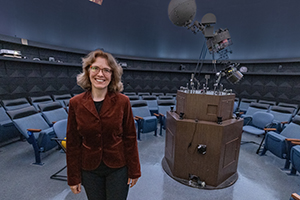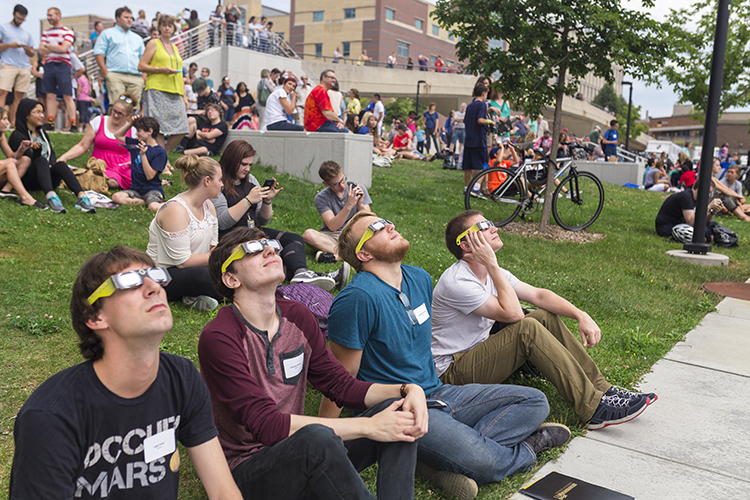The UW-Milwaukee Manfred Olson Planetarium is reaching out to help the local community enjoy the skies through two major efforts this spring.
One is a Solar Eclipse Viewing Party on Monday, April 8, from 1-3 p.m. The other is a new program that is bringing 4,300 Milwaukee Public Schools students to the planetarium between March and June.
The Solar Eclipse Viewing Party will be centered on the UWM Student Union ballroom and Spaights Plaza.
The event is free and open to students, faculty/staff and the public. Food, music and crafts will be available as will 10,000 pairs of special eclipse glasses for safe viewing. The viewing party at UWM will go on rain or shine.
The solar eclipse is the last one visible in the U.S. until 2044. The moon will pass between the Earth and the sun, blocking 90% of the sun in the Milwaukee area. The peak is expected to be at 2 p.m. in this area.
“A solar eclipse represents an intricate dance between the Earth, moon and sun,” said Jean Creighton, director of the UWM Planetarium. Other areas of the U.S. will experience a total eclipse, she added, as the three heavenly bodies will align perfectly for a short period.
In addition to pizza, cookies, refreshments and eclipse viewing, the solar eclipse event will feature opportunities to:
- Watch a NASA livestream of the total eclipse.
- Take a photo at the planetarium photo station or with Pounce.
- Enjoy crafts like decorating eclipse glasses and making galaxy slime with the Studio Arts & Crafts Center.
- Learn how to cross stitch a space-themed pattern with the Women’s Resource Center.
- Make a mindfulness jar with the Student Health and Wellness Center.
In addition to being an occasion for a fun party, the solar eclipse is a learning opportunity, Creighton said.
“The study of solar eclipses has had a profound impact on scientific discoveries and our understanding of the universe.”
Third-graders to visit planetarium
More than 4,300 Milwaukee Public Schools third-graders will have the opportunity to learn more about the skies and planetary bodies throughout the spring.

Planetarium design staff have developed a special program that aligns with the MPS third-grade curriculum by talking about how the height of the sun and the length of the day affects temperatures at different latitudes on Earth. The program compares Milwaukee’s seasonal trends with those in northern Norway; Sydney, Australia; and Nairobi, Kenya.
“This will be an exciting and inspiring field trip for our third-graders,” said Jennifer Mims Howell, MPS chief academic officer. “The planetarium will help illustrate the impact of the sun on the students’ day-to-day lives and give them a new perspective on our solar system and our place in the universe.”
Students will complete activities before and after their visit as part of the curriculum. These activities include graphing temperatures over the year, exploring possible space-related careers and learning about how stars are used in navigation.
“I am thrilled to give our students the chance to look at a dark sky so they can be awed by the beauty of the night sky,” Creighton said.
Creighton has two goals for the student visits.
“I hope that the students will become more curious about what they see around them in the natural world. And, secondly, I hope that the students will consider careers in science, technology, engineering or mathematics.”
***
Those planning to travel out of town for the eclipse (or just unable to join the festivities) can grab a free pair of eclipse glasses at the planetarium show “Prepare for the Solar Eclipse” on Friday at 8:15 p.m. or Saturday at 3:15 p.m. Guided by Creighton, this show dives into the basics of how eclipses work and what we learn from them.






